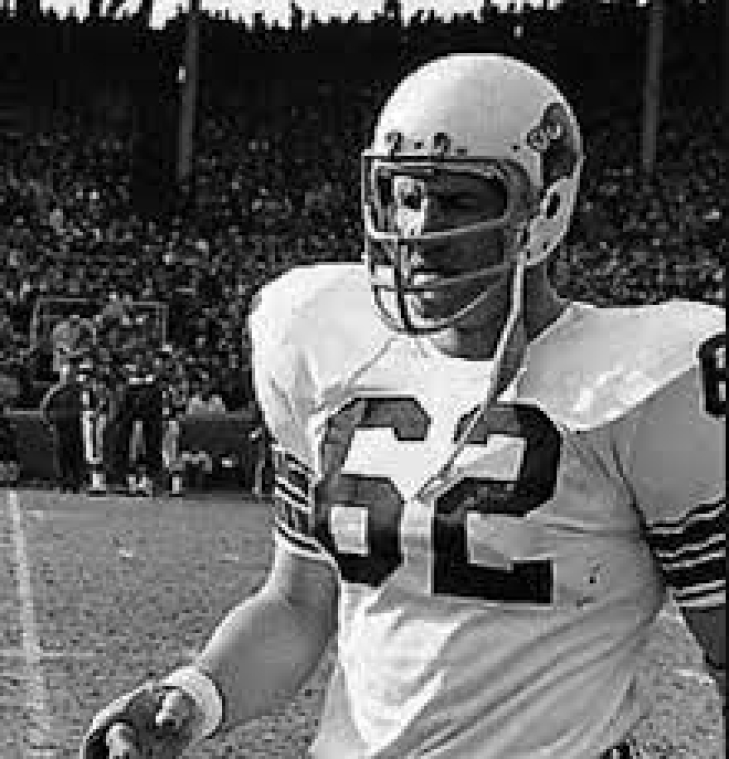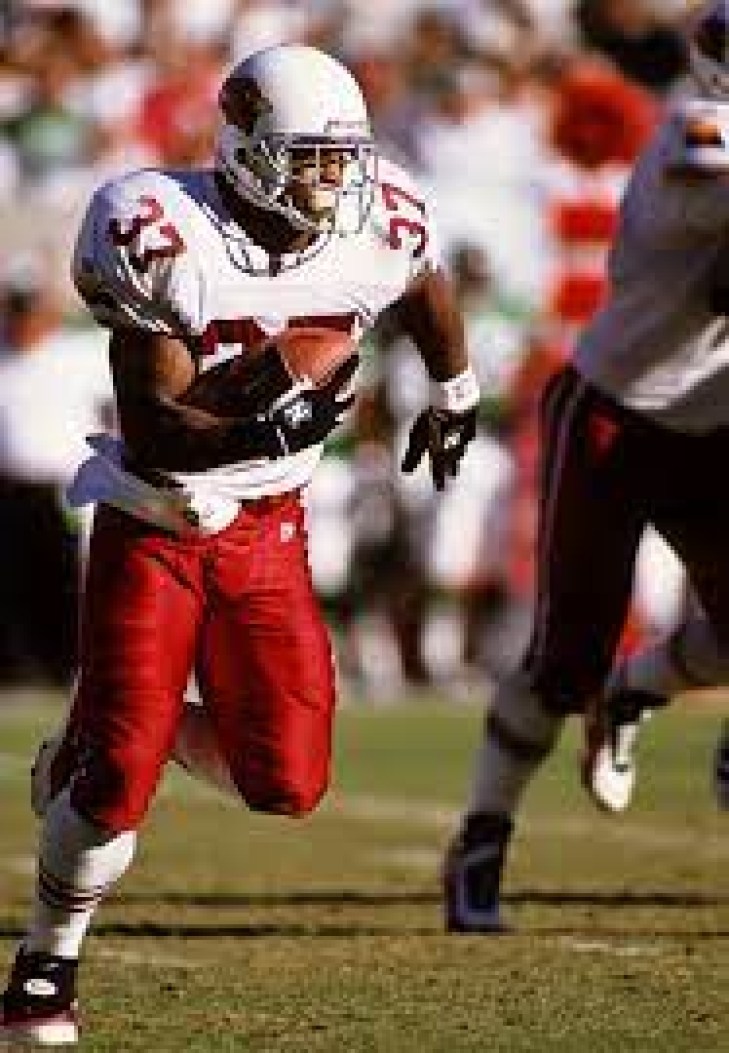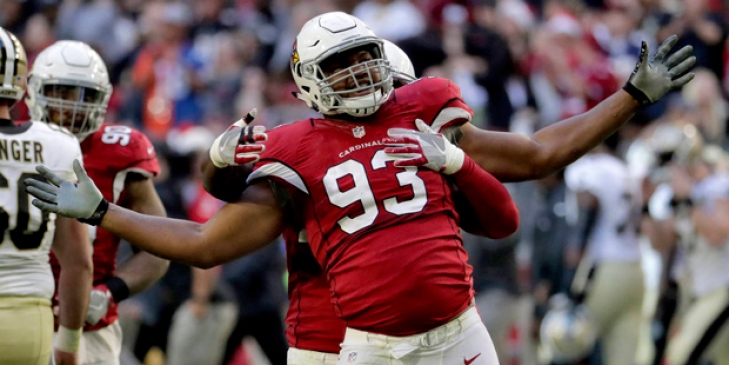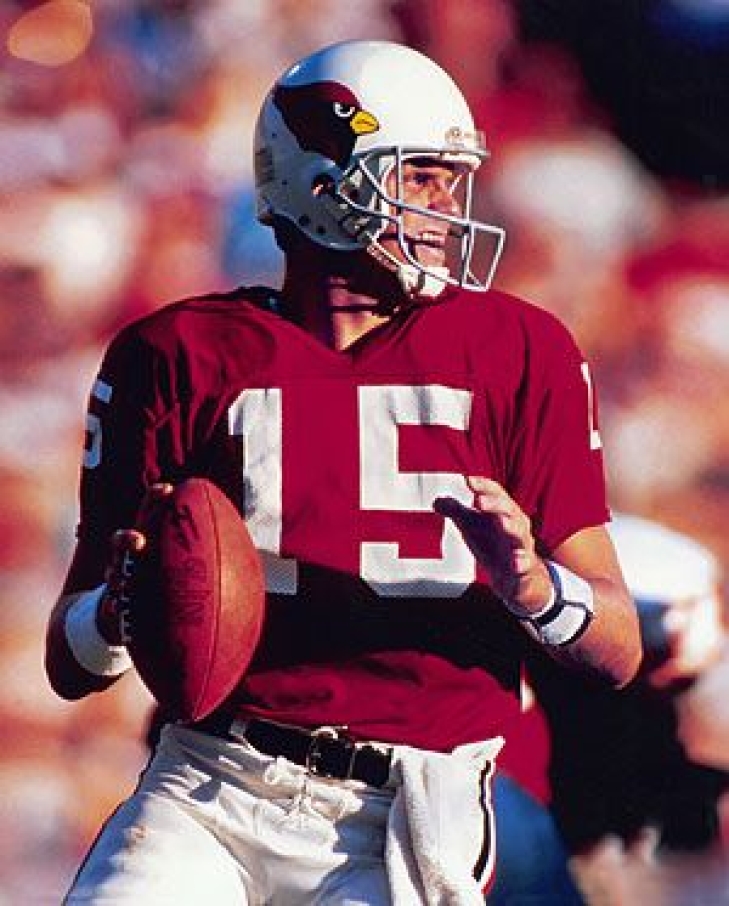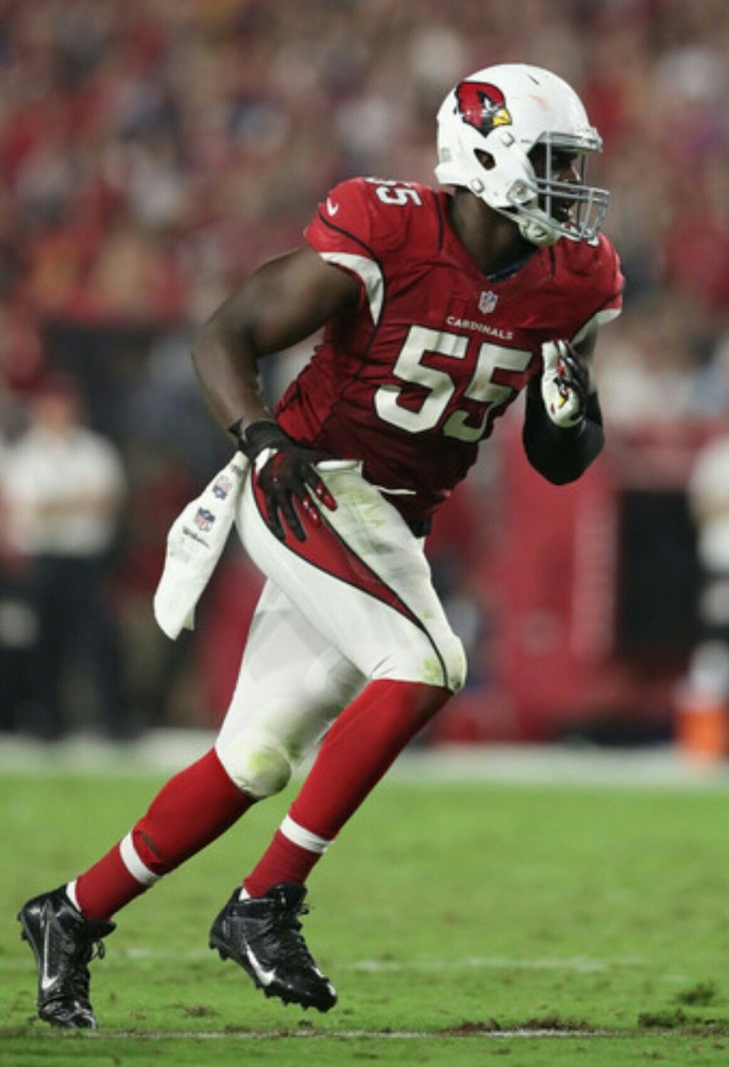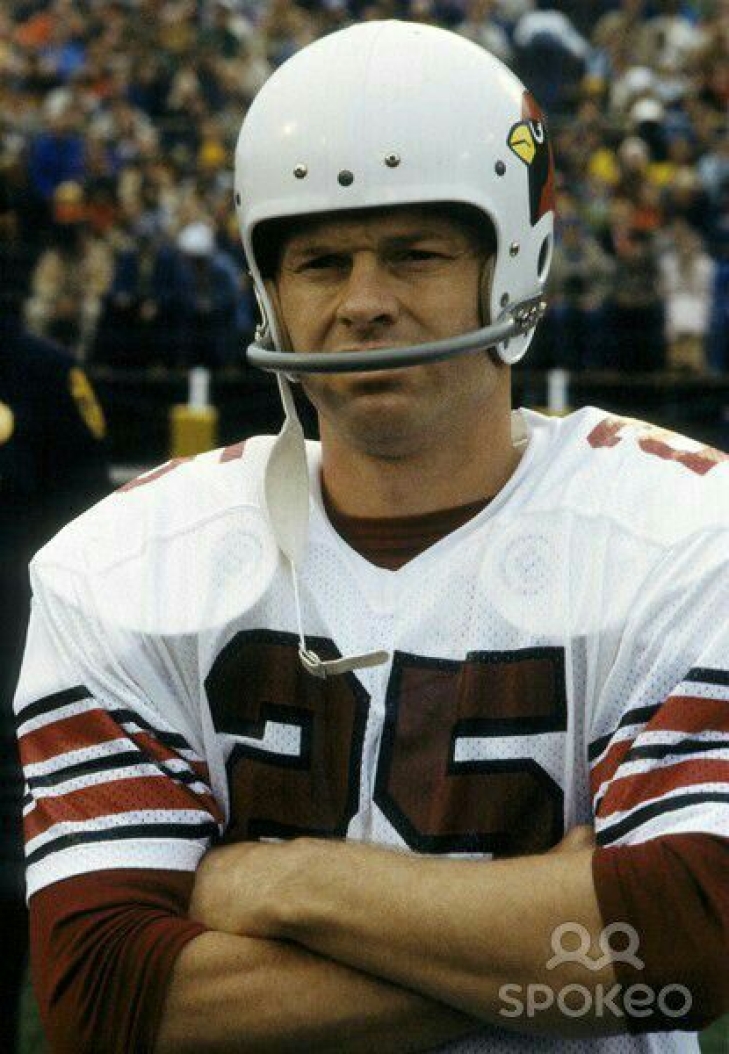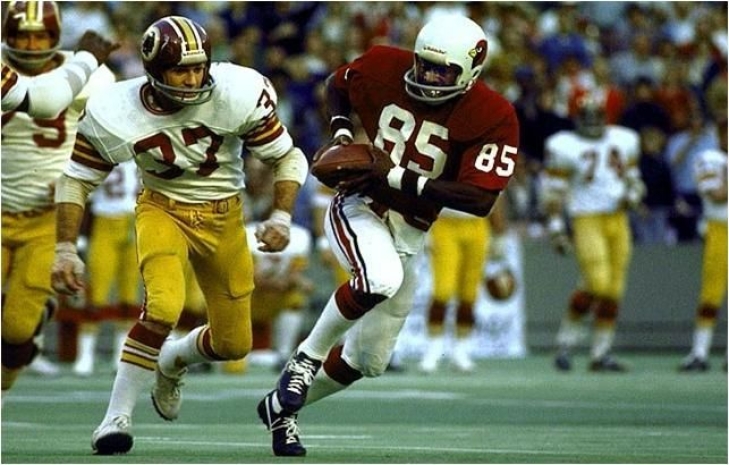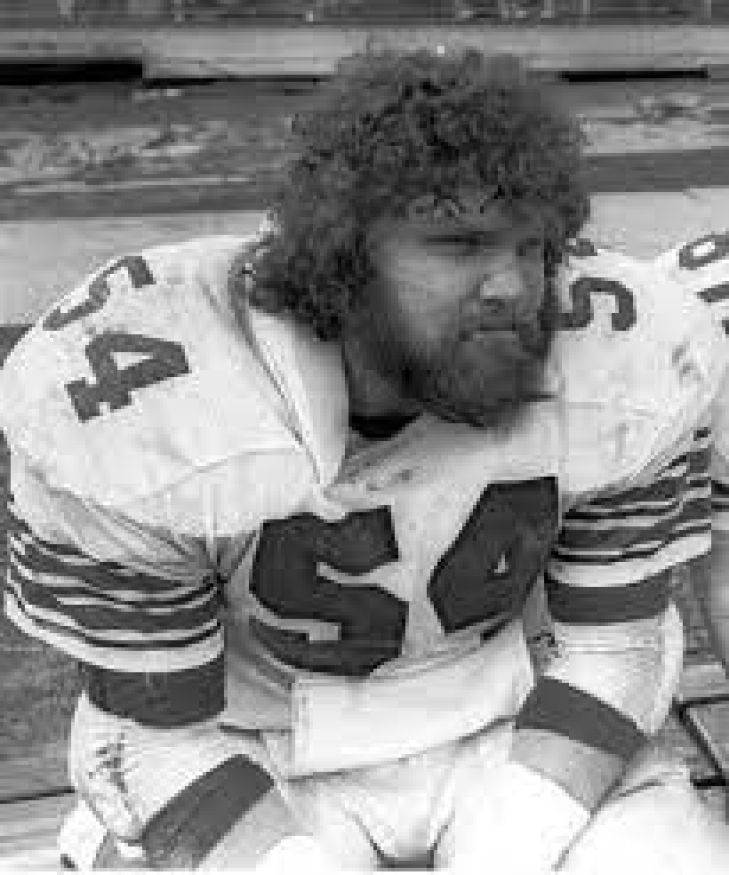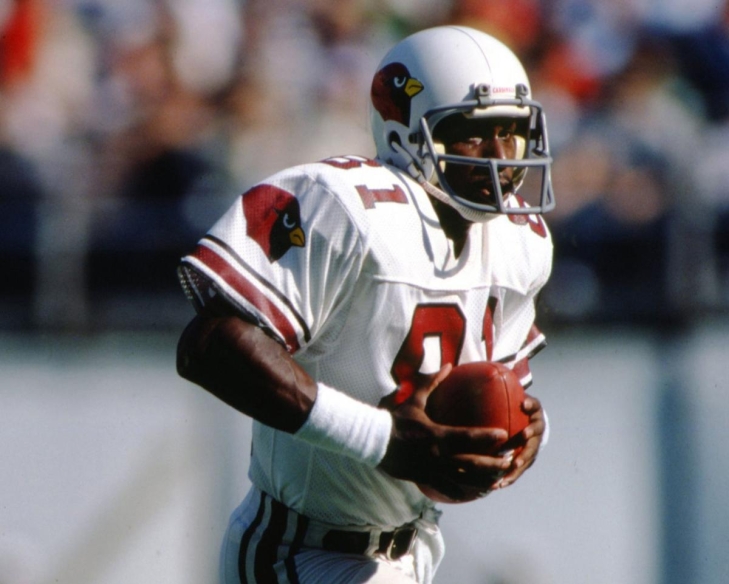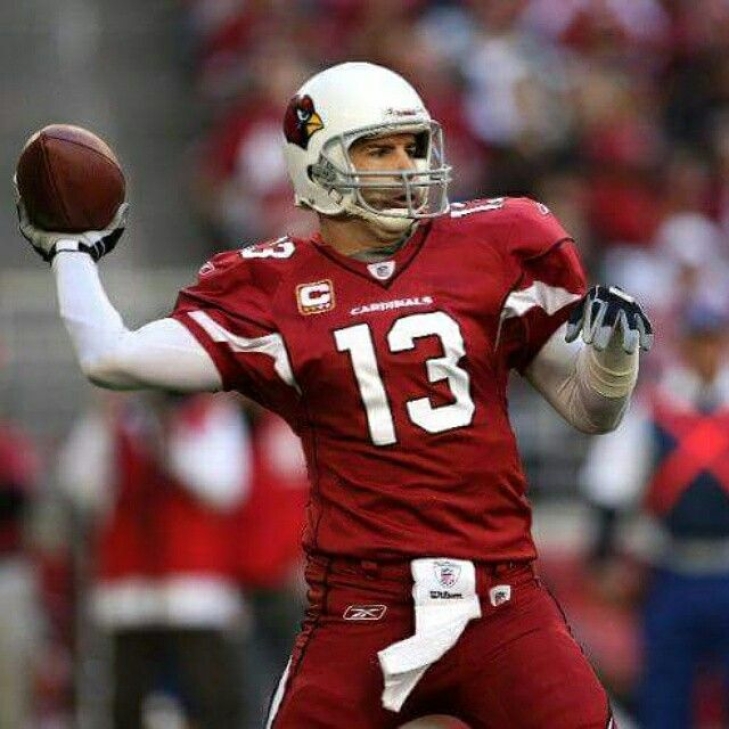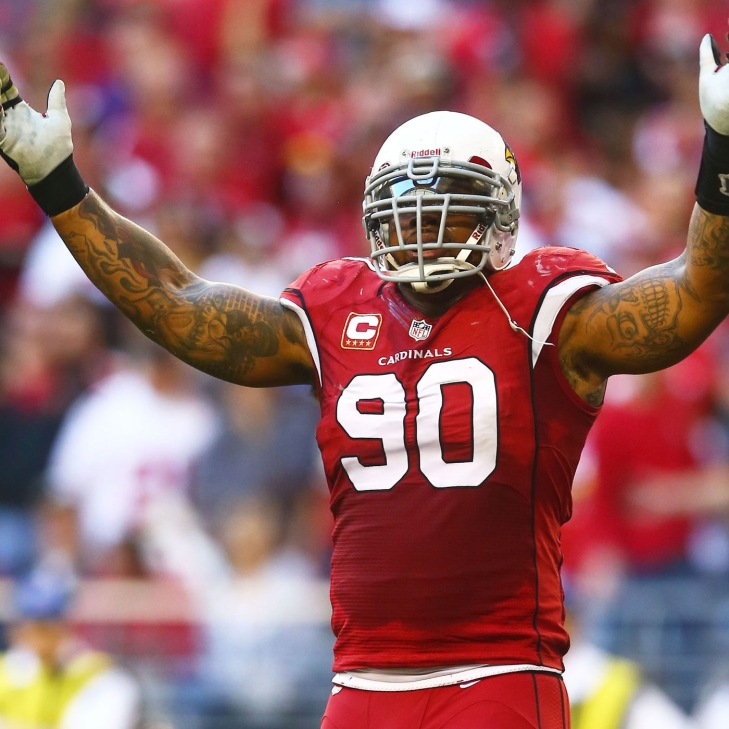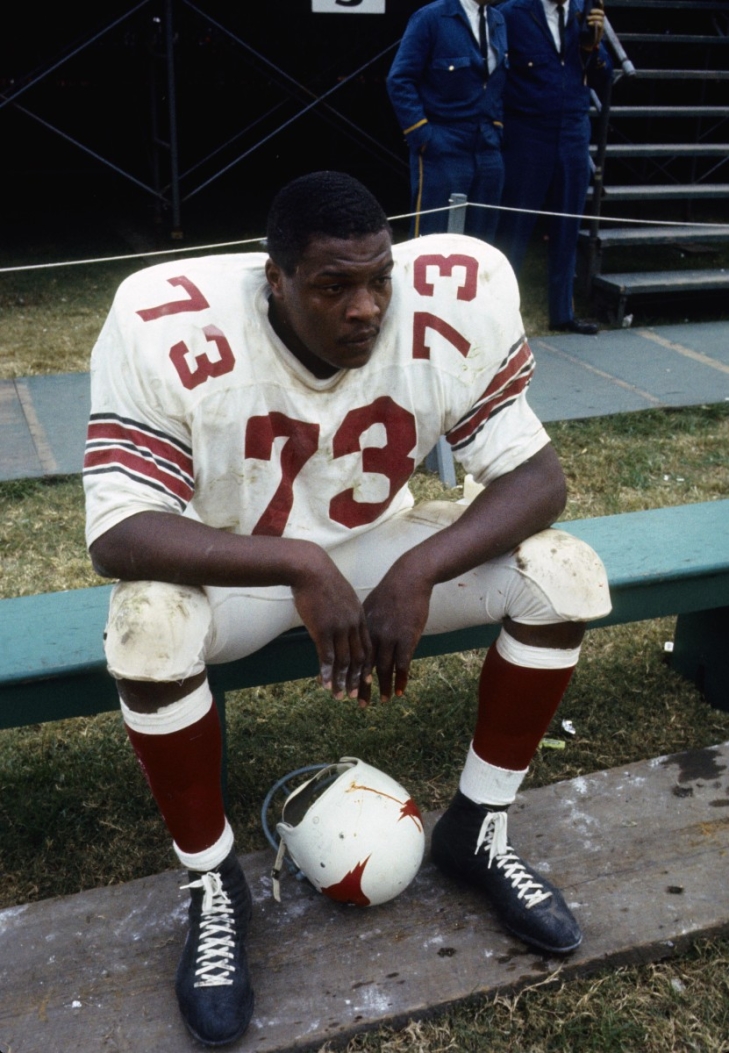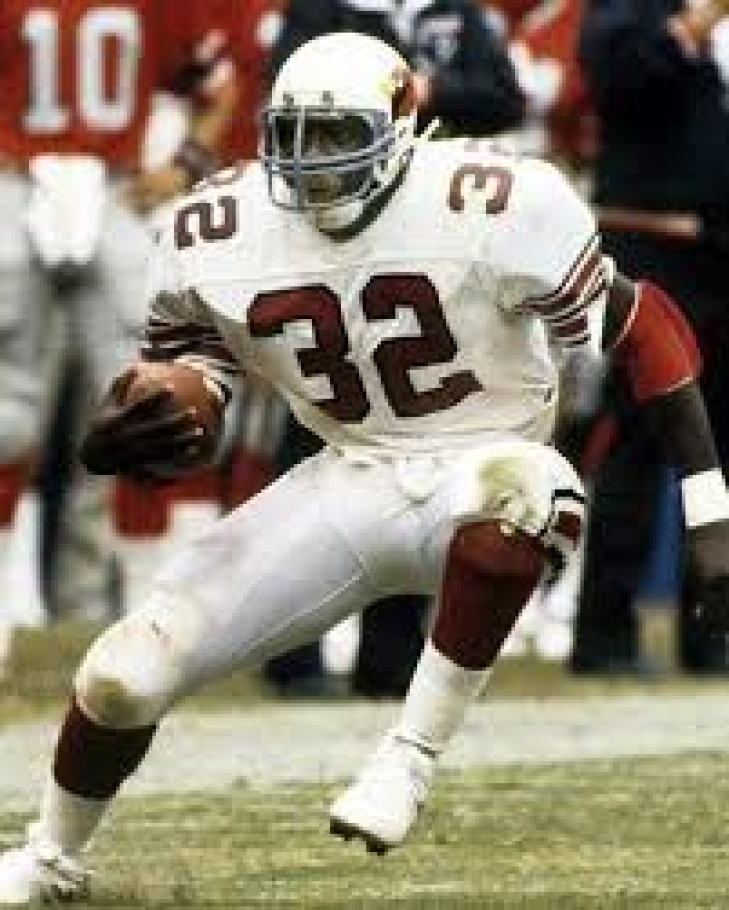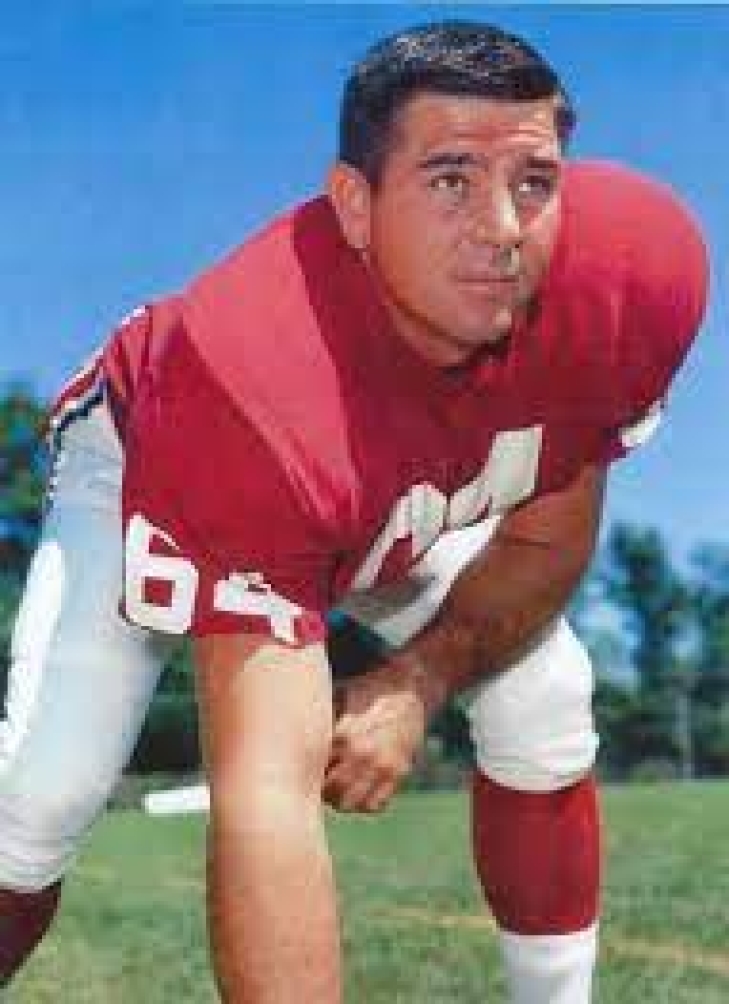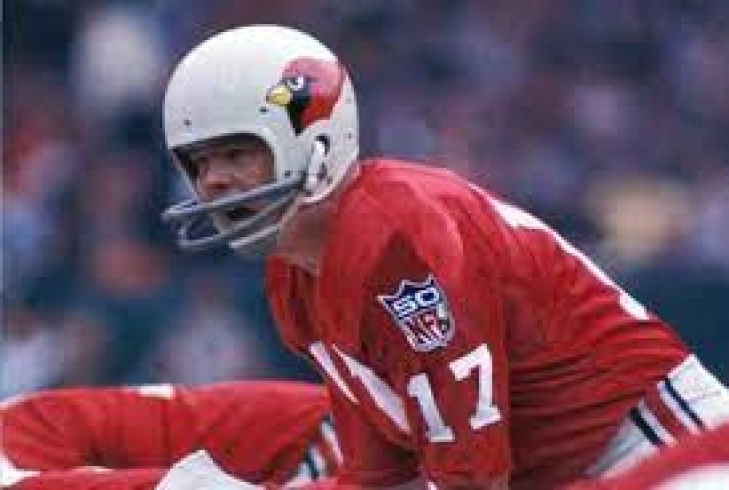Warning: Attempt to read property "params" on null in /home/notinhal/public_html/plugins/k2/k2canonical/k2canonical.php on line 382
31. Dale Meinert
Dale Meinert was initially drafted into the NFL by the Baltimore Colts, but he never played there, instead playing for the Edmonton Eskimos of the Canadian Football League, where he won two Grey Cups. He would return to the United States in 1958, joining the Chicago Cardinals becoming a starting Guard. As the Cardinals relocated to St. Louis in 1960, he was relocated on the gridiron, switching to Middle Linebacker.
Meinert fit better on the defensive side, winning three Pro Bowls and the team MVP in 1961. As the Cardinals were not a league power in the 1960s, Meinert’s contributions are not as celebrated as they should be, but this man was the team's best interior lineman for years.
30. Larry Centers
A product of Stephen F. Austin, Larry Centers was one of their rare draft picks (5th Round in 1990) by the Cardinals, but during the Fullback’s first two seasons, you had to wonder why they selected him at all, as he was barely used.
In his third season, it changed for Centers, who played in all 16 Games and had 50 Receptions, showing himself as one of the rare Fullbacks who would see the pigskin from the air far more than on the ground. He continued increasing his Reception numbers (66 in 1993, 77 in 1994) and had a monster campaign in 1995 with 101 Receptions for 962 Yards and a pair of TDs. Named to his first Pro Bowl that year, his 101 catches made him the first Back of any kind to have at least 100.
Centers was even better in 1996. His receiving numbers were slightly less in two metrics (96 Rec and 786 Yards), but he had career-highs in Receiving Touchdowns (7) and Rushing Yards (425). Centers had two more solid years for Arizona, but in the 1999 off-season, Centers stint with the Cards ended when he was released due to salary cap considerations. As a Cardinal, he had nearly 7,000 All-Purpose Yards and 29 Touchdowns.
29. Calais Campbell
Calais Campbell will go down in history as being more successful in his post-Cardinal career, but it was in Arizona that his career began.
A Second Round Pick in 2008, Campbell helped Arizona make the Super Bowl in his rookie year, and the year after, he became a starter at Left Defensive End. Campbell's skills improved slowly, year by year, and in 2014, he went to his first Pro Bowl, with another following the season. The multi-faceted player did not add a third consecutive Pro Bowl in 2016 but was a Second Team All-Pro, his second and first since 2014.
Campbell signed with Jacksonville in 2017 and, as a Jaguar, won the prestigious Walter Payton Man of the Year in 2019. As a Cardinal, Campbell accumulated 56.5 Sacks, 107 Tackles for Loss, and 501 Combined Tackles.
35. Neil Lomax
A superstar at Portland State, Neil Lomax allegedly set 90 records while he was the Vikings Quarterback. This afforded him a rarity for a Portland State player, a high draft pick (2nd Round in 1981) in the NFL Draft.
Lomax saw action in his inaugural year, learning from the aging Jim Hart, and was an All-Rookie. Playing in the then hyper-competitive NFC East, the Cardinals Quarterback only had two winning seasons and one Playoff Game, but when he was on, he was as good as anyone in the NFL. Twice named to the Pro Bowl, Lomax led the NFL in Pass Completions (275) and Passing Yards (3,387) in 1987 and had 22,771 Yards with 136 Touchdown Passes overall.
An arthritic hip forced Lomax to sit out all of the 1989 Season, and before the next campaign, he retired due to its severity.
28. Chandler Jones
After four seasons with New England, where we won a Super Bowl and went to a Pro Bowl, Chandler Jones was dealt to the Arizona Cardinals, where he had greater individual success.
In his first year in Arizona (2016), the pass rusher had an 11 Sack/15 Tackle for Loss year, continuing his run as a top Edge performer, but he took his skills to another level in 2017. That year, Jones led the NFL in Sacks (17.0) and Tackles for Loss (28) and added a First Team All-Pro, a Pro Bowl, and was third in Defensive Player of the Year voting. After a year at Defensive End when the Cardinals changed their defensive scheme, Jones had his second monster campaign, with a career-high 19.0 Sacks and a league-leading 8 Forced Fumbles. This yielded his second First Team All-Pro and Pro Bowl as a Cardinal. He was inured for most of 2020 but was a Pro Bowler again in 2021 with another double-digit Sack year (10.5).
Jones signed with the Las Vegas Raiders in 2022, leaving the club after 71.5 Sacks, 80 Tackles for Loss and 131 Quarterback Hits.
27. Jim Bakken
Drafted by the Los Angeles Rams in 1962, Jim Bakken did not make the Rams roster out of training camp but was scooped up by the St. Louis Cardinals, a team he would play 15 years for.
Special Teams advanced considerably during Bakken's time, and he was one of an emerging group of specialty Kickers. Chosen for four Pro Bowls and two First Team All-Pros, Bakken is one of the few players to be selected for two All-Decade Teams (60s and 70s), and at one time was the single-game record holder for Field Goals in a Game (7).
His 1,380 Points is by far the most in franchise history.
26. Bob DeMarco
Bob DeMarco centered the Cardinals throughout the 1960s, debuting in 1961 and becoming a starter the year after. DeMarco was solid throughout the decade, netting three Pro Bowls (1963, 1965 & 1967), with the last of the three also seeing him with a First Team All-Pro.
DeMarco left St. Louis after the 1969 season, playing five more years in the NFL. DeMarco started all but five of his 107 Games with the Cardinals, and the franchise never had to worry about Center for eight strong years.
25. Mel Gray
The St. Louis Cardinals did not have to look far to find their next star, Wide Receiver, as Mel Gray played his college ball at the University of Missouri, where his speed is still legendary.
Gray was a Sixth Round Pick in 1971 and broke out in the 1974 campaign, where he began a streak of four consecutive Pro Bowls. While he never had a 1,000-Yard-Receiving nor a 50-Reception year, Gray was the man that the Cardinals viewed for big-money plays, which were much harder to come by in the 1970s than today. Gray was in the top ten in Yards per Reception in seven different years, peaking at second in 1977 with 20.6. He led the league in Touchdown Receptions in 1975 with 11, which coincided with his solitary First Team All-Pro.
After his peak, Gray played for St. Louis until 1982, compiling 45 Touchdowns and 6,664 Receiving Yards.
24. Tom Banks
Tom Banks would become a steal for the St. Louis Cardinals when they got the Auburn Offensive Lineman in the 8th Round of the 1970 Draft, but it would take years to realize that value.
Banks missed the entire 1970 Season because of a knee injury but came back to take over the starting duties at Center. He played more at Left Guard in 1973, but another knee injury took him out of all but the opening game of 1974, right after he returned to Center. Banks remained the starter upon his return and promptly went on a four-year run of Pro Bowls, where he was arguably among the best directly in front of the Quarterback in the NFC. He would also secure a First Team All-Pro in the bi-centennial year of 1976.
Banks played until 1980, retiring with 110 Starts in 116 Games.
23. Anquan Boldin
One of the best Wide Receivers in Cardinals history, Anquan Boldin, made an immediate impact in his 2003 rookie season.
A Second Round Pick from Florida State, Boldin won the Offensive Rookie of the Year on the strength of a 1,377 Yard/8 Touchdown year. Boldin only played 10 Games in 2004 but bounced back with 1,402 Yards and led the NFL Receiving Yards per Game (100.1). A Pro Bowl Selection in 2006 and 2008, Boldin exceeded 1,000 Receiving Yards five times in Arizona, a solid accomplishment over eight seasons. He was traded to Baltimore in 2010, leaving the Cardinals after 44 Touchdowns and 7,520 Yards.
As good as he was on the field, Boldin was a better man off it. He won the Walter Payton Man of the Year and Alan Page Community Award following his Cardinals tenure and continues to be known for his philanthropic endeavors.
22. Luis Sharpe
A Cardinal for the entirety of his 13-year NFL career, Luis Sharpe was the second Offensive Lineman taken in the 1982 NFL Draft, behind only Hall of Famer Mike Munchak. It is a safe assumption that the Cards got the second-best Offensive Lineman of that draft.
Playing for the team while they had geographic designations of St. Louis, Phoenix, and Arizona, Sharpe started all 189 of his Games at Left Tackle, achieving Pro Bowls in three straight years (1987-89) while obtaining Second Team All-Pros in 1988 and 1990. He rarely missed games, stayed relatively healthy for most of his career, and was the building block for over a decade that the Cardinals attempted to build around. The team was not that successful in that regard, as he only appeared in one playoff game, but Sharpe was their top lineman for many years and deserved this spot.
21. Roy Green
In the same draft that the St. Louis Cardinals grabbed an elite Running Back (Ottis Anderson), they landed a top-flight Wide Receiver in Roy Green, though it took longer before that selection paid dividends.
Green was used more as a Returner in his first two seasons before seeing significant action as a Wide Receiver. A permanent starter by 1982, Green broke out in 1983 as a First Team All-Pro and Pro Bowler, leading the NFL in Touchdown Receptions (14) with his first 1,000 Yard year (1,227). Green again was a First Team All-Pro and Pro Bowl Selection in 1984, this time with 12 TDs and 1,555 Yards, with the latter statistic topping the leaderboard.
Green was unable to repeat this success as injuries began to compile, but he did have another four-digit Yard year when the franchise relocated to Phoenix in 1998. He played with the Cardinals for two more seasons before he played two final years in Philadelphia. As a Cardinal, he accumulated 8,496 Yards and 66 Touchdowns and entered the team's Ring of Honor in 2016.
20. Kurt Warner
When you think of Kurt Warner, naturally, the first professional football team you think of (and you should) is the St. Louis Rams, but he did enough in Arizona to extend his legacy and gain an eventual spot in Canton.
Warner signed with Arizona after a year with the Giants, and his first campaign in the desert was disappointing, as Jake McCown even replaced him as the starter for two Games. The year after was much of the same, as rookie Matt Leinart took over as starter for a few Games, but when Warner was on, he was still terrific.
After a better 2007, Warner was electric in 2008, having turned back the hands of time. He went to his first Pro Bowl in years, won the UPI MVP, and took the Cards to their first Super Bowl. Arizona lost, but Warner had a phenomenal postseason, and they would not have been this close without him. After one more good year, Warner retired on his own terms.
Warner entered the Pro Football Hall of Fame in 2017, and we will argue that the 2008 Season with the Cards put him over the hump. Arizona honored Warner with an induction to their Ring of Honor in 2014.
19. Darnell Dockett
Dockett raised his draft value late in his final year at Florida State, and the Cardinals felt he was worthy of their 2004 Third Round Pick. They were proven right.
An All-Rookie and immediate starter at Defensive End, Dockett had his first Pro Bowl in 2007. Two more would follow in 2009 and 2010 when he shifted to Defensive Tackle, with a Second Team All-Pro coming in 2009. A torn ACL kept him out of the 2014 Season, and he was released the following year. Dockett signed with San Francisco but was let go before the season began. He returned to Arizona on a one-day contract to retire as a Cardinal.
Dockett had 40.5 Sacks and 472 Tackles over his career.
18. Ernie McMillan
Save for his final season as a Green Bay Packer, Ernie McMillan enjoyed a long career as a starting Offensive Tackle for the St. Louis Cardinals, a team he played 14 straight years (1961-74).
McMillan started three Games as a rookie in 1961, and over the next 12 years, he was St. Louis's starter at Right Tackle over the next twelve years. The former Fighting Illini went to four Pro Bowls (1965, 1697, 1969 & 1970) and was twice a Second Team All-Pro.
17. Marshall Goldberg
Marshall Goldberg was a major star at the University of Pittsburgh and would ply his trade well for the Chicago Cardinals. Goldberg did it all in the early 1940s, especially in the 1941 season, where he rushed for 427 Yards, received passes for 313 Yards, and was the top finisher in Kick Return Yards (290), earning him the league lead in All-Purpose Yards (1,236) and a Pro Bowl Selection. He would finish fifth in All-Purpose Yards in 1942. Defensively, he had 19 Interceptions, including a league-lead 7 in 1941.
Like many NFL players, he served his country in World War II, and when he came back, he would rejoin Chicago and help them win the NFL Championship in 1947. Historically speaking, Goldberg was also one of the first Jewish stars of the NFL.
The Cardinals enshrined Goldberg into their Ring of Honor in 2006.
16. Ottis Anderson
Ottis Anderson made University of Miami history as the first Running Back to go for over 1,000 Yards. The NFL took notice, and St. Louis, who had the Ninth Overall Pick, grabbed the dual-threat Running Back.
Anderson had one of the best rookie seasons among rushers, what turned out to be his career-high in Rushing Yards (1,605) and Yards From Scrimmage (1,913), and was named the Offensive Rookie of the Year. He was also named a First Team All-Pro, a Pro Bowler, and UPI and The Sporting News elected him as their MVP.
Anderson's second year was also Pro Bowl worthy (Rushing Yards), but it would be his last Pro Bowl Selection, though he was still a potent rusher. Anderson rushed for over 1,000 Yards over three of the following four Seasons and probably would have done so in 1982 had there not been a strike.
The Cardinals traded Anderson in what was a surprise move to their then-division rival, New York. Although Anderson’s Giants numbers paled to his work in St. Louis, he was still solid and would win a Super Bowl MVP for his second and final club.
Anderson compiled over 10,494 Yards From Scrimmage with the Cardinals and 53 Touchdowns.
14. Ken Gray
Ken Gray was drafted by the Green Bay Packers in 1958 but was unable to make their roster. The Chicago Cardinals took a shot on him, using him at Defensive End as a rookie, but the season after, he was moved to Right Guard, a position he would thrive in.
The Cardinals relocated to St. Louis in 1960, and while Gray was not a star in Chicago, he would become one under the Arches. Gray went to his first Pro Bowl in 1961 and added five more (1963, 1964, 1968, 1967 & 1968) with three All-Pros along the way. Arguably the Cardinals' best Offensive Linemen in the 1960s, he began the next decade with Houston, where he played one year before retiring.
12. Jim Hart
As the passing game opened up, many Quarterbacks received their due as national stars. Jim Hart was one of the new breed of pivots, though he did not generate the same buzz as some of his peers.
It wasn't that the Cardinals didn't have any good seasons while Hart played there, as in the mid-70s, they rifled off three consecutive ten-win seasons. This period coincided with Hart's four straight Pro Bowl appearances. Jim Hart became one of the most durable and respected Quarterbacks in the NFL, and due to that durability, he was able to accumulate a very impressive career in terms of statistics.
Unfortunately, as the leader of bad teams for the majority of his career, Hart was considered a good player, who wasn’t good enough to take his team to the next level. This may explain why he never received any real look from football historians, though it should be acknowledged that UPI named Hart their MVP in 1974.
With the Cardinals, Hart amassed 34,639 Yards and an even 200 Touchdown Passes, and he was selected to join the Cardinals Ring of Honor in 2017.
13. Adrian Wilson
Another Cardinal, another Defensive Back.
A Third Round Pick in 2001 from North Carolina State, Wilson would become the team's starting Strong Safety as a sophomore and held that spot for 11 years. Wilson earned his first Pro Bowl in 2006 and would later boast a four-year streak from 2008 to 2011, which included a First Team All=Pro Selection in 2009.
Wilson was released after the 2012 Season, and he signed with New England, but never played there as he tore his Achilles in training camp. He later signed with Chicago but did not make the squad.
Wilson thus retired having only played with the Cardinals, and is one of the few players who accumulated over 25 Sacks and 25 Interceptions. He also recorded over 900 Tackles for the team. In 2015, Wilson entered the Cardinals Ring of Honor.


